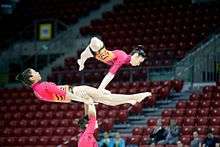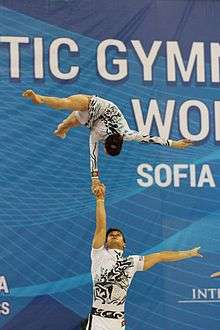Acrobatic gymnastics




Acrobatic Gymnastics (previously called Sport Acrobatics and nicknamed "Acro") is a competitive gymnastic discipline where partnerships of gymnasts work together and perform figures consisting of acrobatic moves, dance and tumbling, set to music. There are three types of routines; a 'balance' routine where the focus is on strength, poise and flexibility; a 'dynamic' routine which includes throws, somersaults and catches, and (at FIG level 6 and above) a 'combined' routine which includes elements from both balance and dynamic.
The sport is governed by the FIG (Fédération Internationale de Gymnastique - or International Federation of Gymnastics). At international level there are four FIG categories of competition defined by age; 11-16, 12-18, 13-19 and 15+ (Senior).
The sport is not an Olympic gymnastic discipline although, possibly due to its recent growth in popularity, there are several campaigns to include it,[1][2] with some suggesting the removal of Rhythmic Gymnastics to make room for Acrobatics.
Acrobatic gymnasts perform in pairs or groups and enter into and are judged at a specific level or age group category. In each partnership, the gymnasts' different sizes and abilities will be balanced to complement each other in order to carry out the complex moves. Some will mainly carry out supporting and pitching (throwing) roles, and are known as bases. They are then balanced with smaller gymnasts who become the 'tops'. The different partnerships seen in competition are:
- women's pair (two females)
- men's pair (two males)
- mixed pair (a male base and a female top)
- women's group (three females)
- men's group (four males)
In competition, partnerships perform a routine to music, that has usually been choreographed specifically for them. The gymnasts carry out their acrobatic moves and combine them with dance, all in time to and in keeping with the style of the music. Partnerships are judged on artistry, difficulty of skill and the execution of skills.
The rules for the sport, known as the Code of Points, are governed by the Fédération Internationale de Gymnastique. These rules are subject to change every four years in line with the Olympic Cycle, as in other disciplines of Gymnastics.
Competitions
Acrobatic gymnastics events form part of the World Games, and are also included in the inaugural European Games as well as having a dedicated Acrobatic Gymnastics World Championships held in even numbered years (known as World Sports Acrobatics Championships prior to 2006), and continental or region championships in odd numbered years. For example, the European Acrobatic Championships are being held in Lisbon, Portugal in October 2013.
There are also numerous National, State and Regional competitions that are held in each Country. Local and regional competitions often form the qualification stages required to compete at national championships. There is no requirement from the FIG for gymnasts to have qualified through their own national championships to compete internationally, but local governing bodies will often make their national team selections based on performance at national competition.
Acrobatic Gymnastics events often attract sizeable audiences, because they are highly entertaining, exhilarating, and suspenseful due to what look to be risky or daring moves. At the London 2012 Olympics, acrobatic partnerships were seen performing before the Olympic gymnastic events, and during the opening and closing ceremonies. It has been said that its appearance, despite not being an Olympic discipline is testament to its ability to entertain.
Gold, Silver and Bronze medals are generally awarded in the usual fashion; although in some competitions, a minimum score is required to qualify for medals.
Routines
Which routines are required at a competition depends on the level at which the gymnasts are competing. At the Junior and Senior levels, all three routines are required, whereas at lower age levels, a single simpler routine is required. Each of the routine types has a different emphasis, but all include tumbling and dance as elements. The different routine types are as follows:
- Balance (formerly known as Static) - A balance routine requires that certain poses or 'balances' and must be held static for a specific duration. These moves require strength, poise, elegance and flexibility. Gymnasts will combine into towers, or pyramids with the tops holding a particular position balanced on their bases. Traditionally, balance routines were often performed to slower music, but not exclusively so.
- Dynamic (formerly known as Tempo) - These routines demonstrate power, strength and grace through the performance of acrobatic moves that involve the phases of spring, flight, rotation and landing. This often involves the base, or bases in the partnership propelling the top through the air and through a series of somersaults or twists. The top is generally caught, or supported in the landing by their base(s).
- Combined - At the more senior levels of competition, a third routine must be performed that combines both Balance and Dynamic moves, along with the usual tumbling and dance.
Scoring
The Acrobatic Gymnastics competitions are judged on a score out of 30.00, with 10.00 assigned for each of the following:
- an Artistic component which evaluates the acrobats performance in terms of choreography, diversity and ability to perform to the music;
- an Execution component which evaluates the deductions incurred by the Acrobats whilst performing the partner and individual skills of the routine (for example, bent legs or unpointed toes); and
- a Difficulty component which is the overall equivalent score based on the degree of difficulty and number of skills (the Difficulty score is determined by the value allocated to skills according to the Code of Points).
In the Senior age group, routines can carry a difficulty tariff of greater than 10, meaning that scores of over 30 are not uncommon.
Judging
The judging panels of Acrobatic Gymnastics are similar to other disciplines of gymnastics where different panels of judges are overseen by a Head Judge, and each panel has a 'Chair of the Judging Panel'(CJP) who oversees that panel's activities. In Acrobatic Gymnastics there are then Difficulty judges (DJ) who only assess the difficulty of the elements in the routines; Artistic judges (AJ) who only assess the performance and artistic merits of the routine; and Execution judges (EJ) who only judge what points should be deducted based on imperfect execution of individual elements in the routine. The numbers of each type of judge on an Acrobatic panel depends on the level of the competition and can vary from one to many (with the exception of the Chair, as there is only one CJP per panel).
History
The first use of acrobatics as a specific sport was in the Soviet Union in the 1930s and the first world championships were in 1974.[3]
In addition to the current five categories, two additional categories for tumbling (men's and women's) were included until the 1999 World Championships, though some groups still involve tumbling events.[4]
See also
References
External links
| Wikimedia Commons has media related to Acrobatic gymnastics. |
- Acrobatics on the FIG website
- Acrobatic Gymnastics on USAG website
- Acrobatic Gymnastics on the British Gymnastics website
- Gymnastics on the Japan Acrobatic Gymnastics Association website
| ||||||||||||||||||||||
| ||||||||||||||||||||||||||||||||||||||